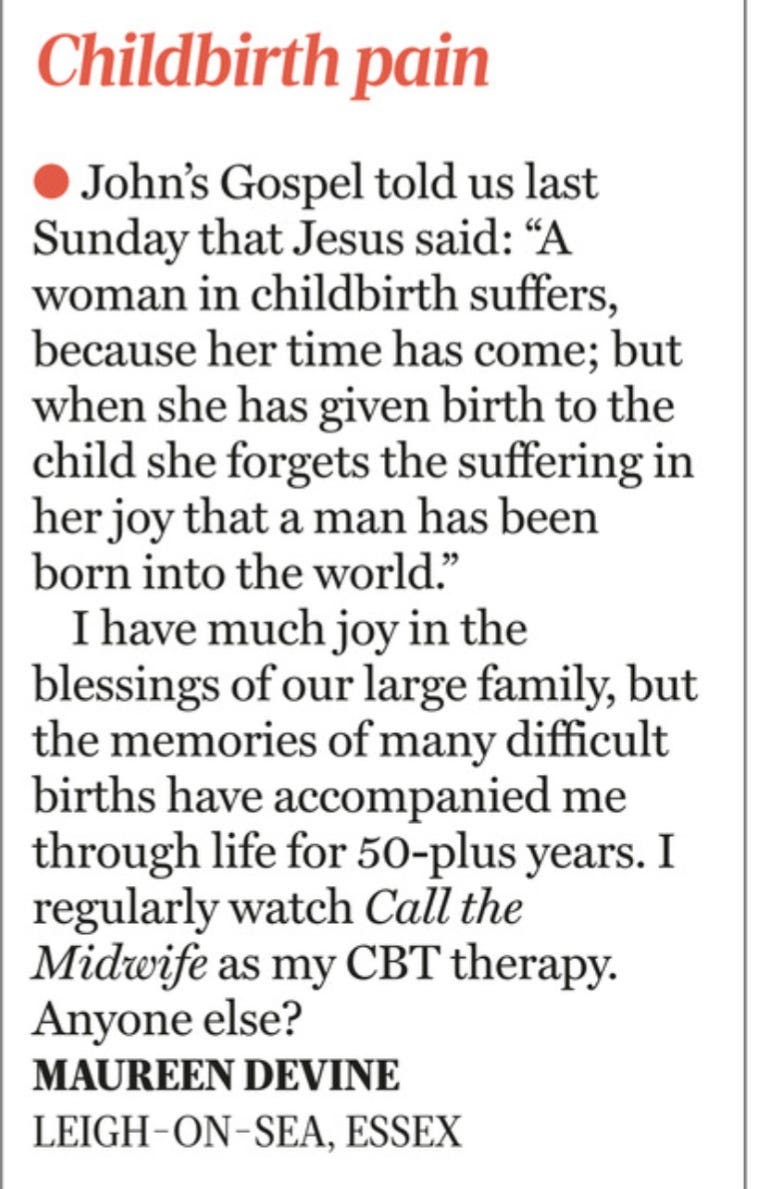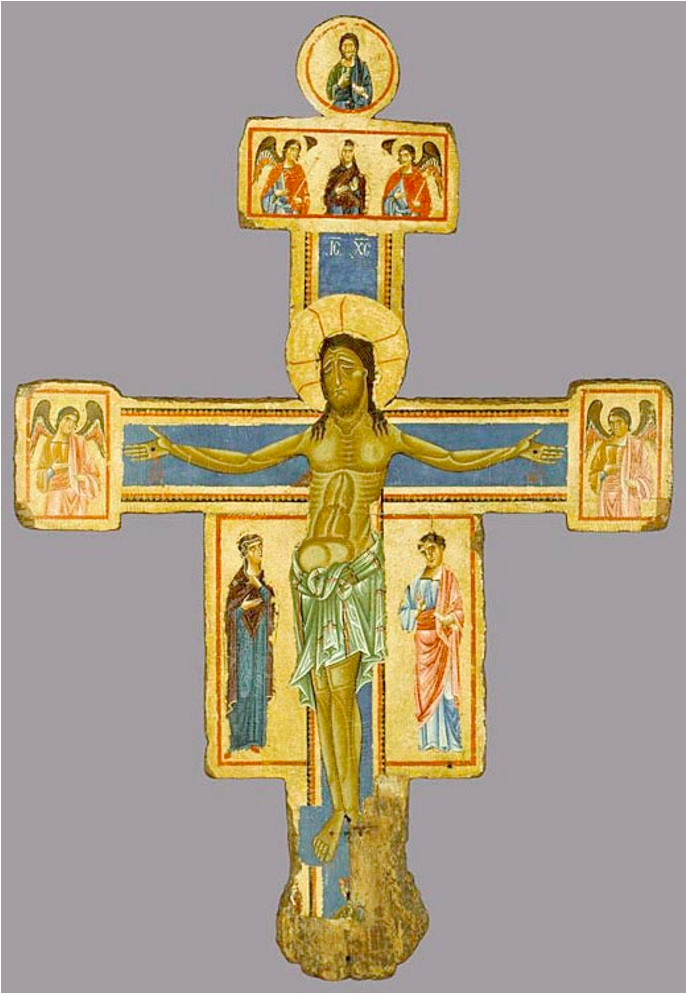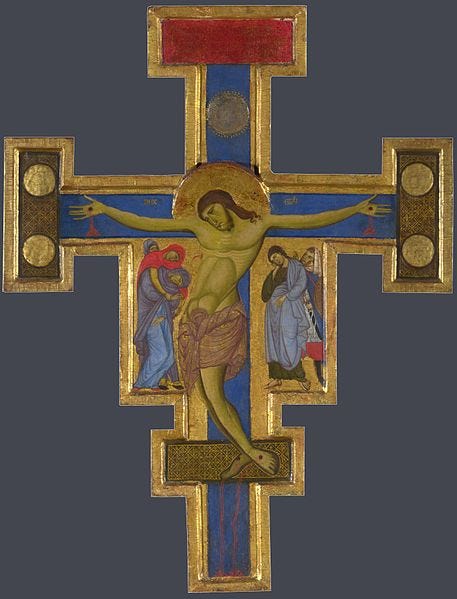Here are two letters published in the Catholic weekly, The Tablet. Maureen Devine’s was published in the issue dated 25th May, and my response is in this week’s issue dated 1st June:
My letter refers to depictions of Jesus giving birth on the cross in medieval art and devotion. I thought some readers might like to know more about this tradition, so here are some links and sources.
This is an extract from my essay “Gendering Genesis, Engendering Difference”, Svensk Teologisk Kvartalskrift. Årg. 92 (2017): 102-117—available to download (open access) at this link.
The Polymorphous Body of the Crucified Christ
There is a strange era in the art of the crucifixion between the twelfth and fourteenth centuries, in which Christ’s torso appears in the form of a phallus. Leo Steinberg has written about the exposed or thinly veiled genitals of Christ in The Sexuality of Christ in Renaissance Art and Modern Oblivion, a phenomenon that he attributes in part to the rise of the Franciscan order in the thirteenth century with its injunction “naked to follow the naked Christ”. Steinberg suggests that “Nakedness becomes the badge of the human condition which the Incarnation espoused.”1
While many of the images to which Steinberg refers are realistic in their representation of Christ’s body, I am referring to an effect that comes about through the exaggeration of Christ’s abdominal muscles and ribcage on the cross. While the ribcage can be a way of expressing Christ’s suffering, in these images the phallic symbolism is clearly visible. If we look more closely, we see that in some such images, the wound in Christ’s side is spurting the body fluids of blood and water in the direction of his mother at the foot of the cross. The fluids that flow from Christ’s wound are birth fluids — water and blood flow from bodies in childbirth, not in death. These are baptismal fluids — the fluids of rebirth into eternal life. “Unless one is born again, he cannot see the kingdom of God”, Jesus tells Nicodemus. (Jn. 3:3)
The wound in Christ’s side was commonly described in terms of the birthing maternal body in patristic and medieval theology, with Christ giving birth to the Church in the same way that Eve was ‘birthed’ from the side of Adam.2 Together, I would suggest that the bleeding wound and the phallic torso in images such as these symbolise impregnation and birth. On the cross, Christ impregnates his own body through the vaginal wound in his side, in order to give birth to the maternal Church in whose sacraments his body will henceforth become food for the life of the world.
To speak of the transgendered, polymorphous body of Christ in the Church is not to advocate a postmodern parody of embodiment in which the finite body with all its markers of sexuality and difference, limitation and fragility, is eliminated by the symbolic and the performative. It is to affirm the sacramental mystery wherein bodies are birthed anew in a unity that is neither one nor two, in a maternal body that is neither one nor two, in a Trinitarian undoing of the self through ecstatic union with God and fleshy communion with the desiring, suffering other.
There are many other sources that explore this maternal tradition.
See this short reflection by Teresa Berger: “Good Friday: Jesus’ Death on the Cross as Birthing?” Berger quotes the Carthusian writer, Marguerite d’Oingt (d. 1310), comparing the crucifixion to childbirth:
“Are you not my mother and more than mother? … Oh, Sweet Lord Jesus Christ, who ever saw any mother suffer such a birth! But when the hour of the birth came you were placed on the hard bed of the cross where you could not move or turn around or stretch your limbs as someone who suffers such great pain should be able to do; … And surely it was no wonder that your veins were broken when you gave birth to the world all in one day.”
When reading such vivid descriptions of childbirth, it might be helpful to remember that, before developments in obstetric care, dying in childbirth was a very real risk for women. Still today, nearly 300,000 of the world’s poorest women die in childbirth every year. This is one of the most avoidable and traumatising effects of poverty but it has yet to find any acknowledgement in church teaching documents, perhaps because it would require a new approach to questions of women’s reproductive health and rights.
In a review of Grace Hamman’s book, Jesus through Medieval Eyes,3 Amy Mantravadi writes of “one of the strangest ways that medieval Christians understood Christ”. She goes on to quote Hamman:
“The side-wound themes and imagery invert the traditional roles of Christ as bridegroom and the Soul as bride by portraying Jesus as the one who is inviting his beloved into his body. Christ’s side wound was often drawn shaped like a vulva … In some illustrations, Christ even gives birth from his side wound. He is the mother of the church, his wounds the womb through which we are born again. As our lover, he is profoundly fruitful. He forms us in blooming beauty through his tender desire”4
Mantravadi continues:
Hamman observes that not only Julian of Norwich, but even such esteemed doctors of the church as Bernard of Clairvaux, Anselm of Canterbury, and Aelred of Rievaulx spoke of Jesus in maternal terms. Indeed, this was one of the chief ways that medieval Christians understood their Savior. “They wrote Jesus as a pregnant, laboring, and postpartum mother: lactating, bleeding, meant to be adored and imitated in his long-suffering mercy and compassion. The crucifixion and childbirth meet at a strange point of willing love and willing suffering in the service of abundant life.”5
Emma Cieslik’s “‘Our true Mother' — interpreting a genderqueer Jesus” also draws on this tradition. She writes:
Scholars today have explored how this wound, as central to Christ's suffering and death, connects to menstruation, lactation and giving birth. Caroline Walker Bynum explains that Christ's body suffers and releases liquids like blood in line with menstruation, a process traditionally experienced by women. In her monograph Holy Feast and Holy Fast, Bynum emphasises that Christ giving his body for his disciples to eat at the Last Supper is also a traditionally maternal-coded ability. Theologian Julian of Norwich is one of many who described Jesus in the 1300s as 'our true Mother', citing Jesus's ability to feed us with himself as a lactating person feeds a child with their own milk and enlivens them with this nourishment.
Cieslik points out how often the paint in such images has been worn away by the repeated stroking and kissing of devotees. I’m reminded of when I was recording a BBC radio programme about such images in the National Gallery in London. I showed the presenter a 13th century crucifix in which this fertility symbolism is clearly evident. She spontaneously stepped forward and ran her hand down the body of Christ in this priceless work of art! The security guard leapt to his feet, by which time she’d already withdrawn her hand in shock at what she’d done.
To see how irrepressibly people are drawn to touch these devotional images, I recommend standing outside the vast bronze doors of the Duomo in Milan. The depiction of Mary Magdalene stroking the hand of the risen Christ has been polished to a gleaming patina by hundreds of thousands of people who cannot resist touching the forbidden touch. I wrote an earlier post about this, which you can read here.
These are just tastes and glimpses of a brief but fascinating era in the Christian story. Today, as questions of women’s ordination continue to rise to the surface no matter how hard the Catholic hierarchy tries to suppress them, might there yet be insights and revelations in the tradition that would support the case for the female body as priest, standing in persona Christae?
When I had the privilege of supervising Revd Dr Ali Green’s PhD, she explored the symbolic significance of the female priesthood through the liturgical language of the Eucharistic prayers. When these prayers were read through a feminist lens, she discovered rich themes of fecundity and birth. A coherent theology of women’s priesthood is ready and waiting to be incorporated into the Church’s sacramental theology.
Leo Steinberg, The Sexuality of Christ in Renaissance Art and Modern Oblivion, 2nd edn. (Chicago and London: The University of Chicago Press, 1996), 33.
Cf. Caroline Walker Bynum, Jesus as Mother: Studies in the Spirituality of the High Middle Ages (Berkeley: University of California Press, 1982), Bynum, Wonderful Blood: Theology and Practice in Late Medieval Northern Germany and Beyond (Philadelphia: University of Pennsylvania Press, 2007). For a summary of scholarly hypotheses and debates on this topic, see Sarah Alison Miller, Medieval Monstrosity and the Female Body (London and New York: Routledge, 2013): 119 ff.
Grace Hamman, Jesus through Medieval Eyes: Beholding Christ with the Artists, Mystics, and Theologians of the Middle Ages (Grand Rapids: Zondervan Reflective, 2023).
Hamman, pp. 52-3.
Hamman, p. 117.











